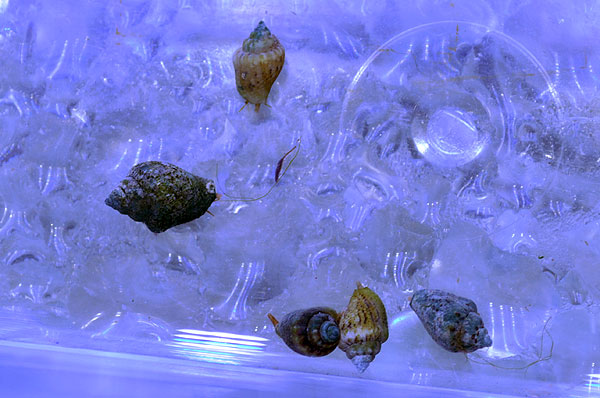With sustainability at the forefront of this project, the moment I saw this in my tank I knew I was ready for the next step. Tuesday, I decided to tackle this:
I didn’t go rushing out for a couple dozen Astrea snails or Dwarf Blue Legged Hermits from Florida. No, I opted to look at my own tanks and there’s some interesting things going on.
For years now, I’ve had these little limpets. These tiny algae eating snails never seem to get algae growing on themselves, and they happily reproduce in my tanks. They don’t seem to get out of control, nor do they get very large. That makes them great for cleaning every little crevice.
When visiting Colorado last year for Reef Ed by MASC, I got to see Joe Thompson and Andrew Berry, two marine breeders (both MBI Council members) who introduced me to the spineless side of breeding – inverts! Andy and Joe each gave me their speciality. Joe’s snails I think are all gone, but Andy’s RSF Collumbelid snails, which may or may not be the same as the Indo Pacific Sea Farms “Strombus Grazers”. Regardless, these great little snails readily reproduce in the aquarium, laying small egg cases which hatch out little baby snails!
So I’m obviously being careful about WHERE things come from too. The Limpets came from the tank that houses the future mate of the Lightning Maroon. The Columbelid snails came from a 10 gallon tank that hasn’t seen any new fish in maybe 6 months. In addition to these snails, I also harvested about a dozen Amphipods from the refugium on my larviculture system. They were rinsed in clean saltwater and then removed and introduced by hand.
When I talk about breeding marine fish, I talk about preserving the future of our hobby given what I perceive as the inevitable loss of wild caught sources for our fish sometime in this century. What we don’t often think about are things less sexy – the snails, hermit crabs, and other organisms that help our reef tanks function properly. While this “starter crew” is not nearly enough to keep the tank free of algae, they will contribute to a hopefully self-sustaining population of cleanup critters that will readily reproduce in the tank. In theory, I shouldn’t have to revitalize my cleanup crew in a year when half of them have died off (as you would with things that don’t reproduce so readily).
There will be another captive-bred introduction in a few weeks time. I won a gift certificate to Aloha Corals, and it just so happens that Aloha Corals breeds and rears the Hawaiian Turbo Snail. So, after going through QT, these guys will get added too! If I can get my hands on some of the RSF Nassarius that I got from Joe earlier, and maybe some Stomatellas, I’ll hopefully have a 100% captive-bred snail crew to handle all the cleanup needs of this tank. It’s truly exciting to think about how this may impact the future of our hobby.




Recent Comments